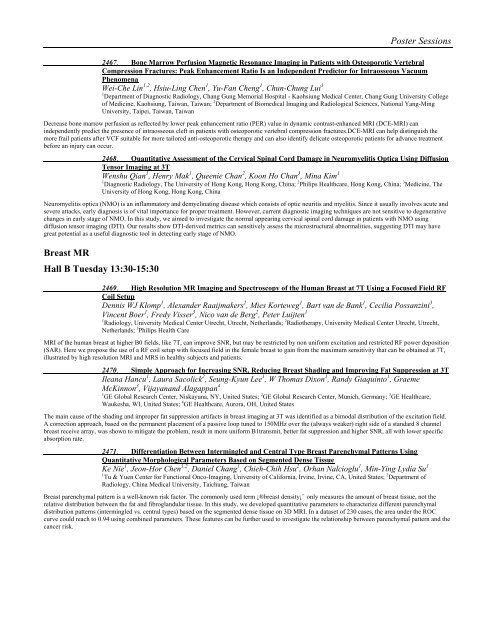TRADITIONAL POSTER - ismrm
TRADITIONAL POSTER - ismrm
TRADITIONAL POSTER - ismrm
Create successful ePaper yourself
Turn your PDF publications into a flip-book with our unique Google optimized e-Paper software.
Poster Sessions<br />
2467. Bone Marrow Perfusion Magnetic Resonance Imaging in Patients with Osteoporotic Vertebral<br />
Compression Fractures: Peak Enhancement Ratio Is an Independent Predictor for Intraosseous Vacuum<br />
Phenomena<br />
Wei-Che Lin 1,2 , Hsiu-Ling Chen 1 , Yu-Fan Cheng 1 , Chun-Chung Lui 1<br />
1 Department of Diagnostic Radiology, Chang Gung Memorial Hospital - Kaohsiung Medical Center, Chang Gung University College<br />
of Medicine, Kaohsiung, Taiwan, Taiwan; 2 Department of Biomedical Imaging and Radiological Sciences, National Yang-Ming<br />
University, Taipei, Taiwan, Taiwan<br />
Decrease bone marrow perfusion as reflected by lower peak enhancement ratio (PER) value in dynamic contrast-enhanced MRI (DCE-MRI) can<br />
independently predict the presence of intraosseous cleft in patients with osteoporotic vertebral compression fractures.DCE-MRI can help distinguish the<br />
more frail patients after VCF suitable for more tailored anti-osteoporotic therapy and can also identify delicate osteoporotic patients for advance treatment<br />
before an injury can occur.<br />
2468. Quantitative Assessment of the Cervical Spinal Cord Damage in Neuromyelitis Optica Using Diffusion<br />
Tensor Imaging at 3T<br />
Wenshu Qian 1 , Henry Mak 1 , Queenie Chan 2 , Koon Ho Chan 3 , Mina Kim 1<br />
1 Diagnostic Radiology, The University of Hong Kong, Hong Kong, China; 2 Philips Healthcare, Hong Kong, China; 3 Medicine, The<br />
University of Hong Kong, Hong Kong, China<br />
Neuromyelitis optica (NMO) is an inflammatory and demyelinating disease which consists of optic neuritis and myelitis. Since it usually involves acute and<br />
severe attacks, early diagnosis is of vital importance for proper treatment. However, current diagnostic imaging techniques are not sensitive to degenerative<br />
changes in early stage of NMO. In this study, we aimed to investigate the normal appearing cervical spinal cord damage in patients with NMO using<br />
diffusion tensor imaging (DTI). Our results show DTI-derived metrics can sensitively assess the microstructural abnormalities, suggesting DTI may have<br />
great potential as a useful diagnostic tool in detecting early stage of NMO.<br />
Breast MR<br />
Hall B Tuesday 13:30-15:30<br />
2469. High Resolution MR Imaging and Spectroscopy of the Human Breast at 7T Using a Focused Field RF<br />
Coil Setup<br />
Dennis WJ Klomp 1 , Alexander Raaijmakers 2 , Mies Korteweg 1 , Bart van de Bank 1 , Cecilia Possanzini 3 ,<br />
Vincent Boer 1 , Fredy Visser 3 , Nico van de Berg 2 , Peter Luijten 1<br />
1 Radiology, University Medical Center Utrecht, Utrecht, Netherlands; 2 Radiotherapy, University Medical Center Utrecht, Utrecht,<br />
Netherlands; 3 Philips Health Care<br />
MRI of the human breast at higher B0 fields, like 7T, can improve SNR, but may be restricted by non uniform excitation and restricted RF power deposition<br />
(SAR). Here we propose the use of a RF coil setup with focused field in the female breast to gain from the maximum sensitivity that can be obtained at 7T,<br />
illustrated by high resolution MRI and MRS in healthy subjects and patients.<br />
2470. Simple Approach for Increasing SNR, Reducing Breast Shading and Improving Fat Suppression at 3T<br />
Ileana Hancu 1 , Laura Sacolick 2 , Seung-Kyun Lee 1 , W Thomas Dixon 1 , Randy Giaquinto 1 , Graeme<br />
McKinnon 3 , Vijayanand Alagappan 4<br />
1 GE Global Research Center, Niskayuna, NY, United States; 2 GE Global Research Center, Munich, Germany; 3 GE Healthcare,<br />
Waukesha, WI, United States; 4 GE Healthcare, Aurora, OH, United States<br />
The main cause of the shading and improper fat suppression artifacts in breast imaging at 3T was identified as a bimodal distribution of the excitation field.<br />
A correction approach, based on the permanent placement of a passive loop tuned to 150MHz over the (always weaker) right side of a standard 8 channel<br />
breast receive array, was shown to mitigate the problem, result in more uniform B1transmit, better fat suppression and higher SNR, all with lower specific<br />
absorption rate.<br />
2471. Differentiation Between Intermingled and Central Type Breast Parenchymal Patterns Using<br />
Quantitative Morphological Parameters Based on Segmented Dense Tissue<br />
Ke Nie 1 , Jeon-Hor Chen 1,2 , Daniel Chang 1 , Chieh-Chih Hsu 2 , Orhan Nalcioglu 1 , Min-Ying Lydia Su 1<br />
1 Tu & Yuen Center for Functional Onco-Imaging, University of California, Irvine, Irvine, CA, United States; 2 Department of<br />
Radiology, China Medical University, Taichung, Taiwan<br />
Breast parenchymal pattern is a well-known risk factor. The commonly used term ¡®breast density¡¯ only measures the amount of breast tissue, not the<br />
relative distribution between the fat and fibroglandular tissue. In this study, we developed quantitative parameters to characterize different parenchymal<br />
distribution patterns (intermingled vs. central types) based on the segmented dense tissue on 3D MRI. In a dataset of 230 cases, the area under the ROC<br />
curve could reach to 0.94 using combined parameters. These features can be further used to investigate the relationship between parenchymal pattern and the<br />
cancer risk.















